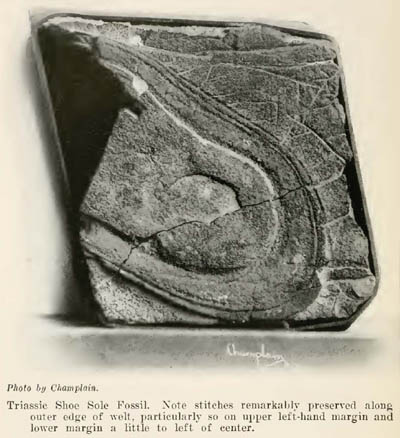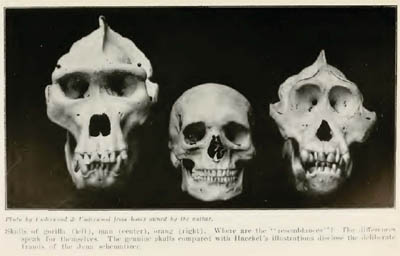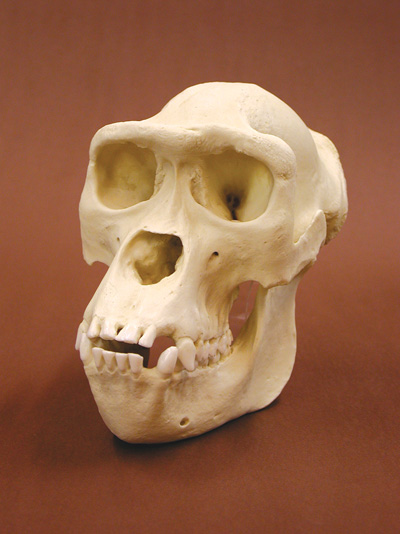Book Review - God- or Gorilla?, Appendices, Part II (And the End of The Book)
This entry is part of a series. For a bit of an introduction and an index of all entries in the series, go here.
 This installment covers the final appendices.
This installment covers the final appendices.
Here's a rather inconsistent argument.
[quoting G Frederick Wright -jrl] "But between 1680 and 1766 the Falls [Niagara Falls -jrl] had evidently receded about 412 feet. Between 1766 and 1856 the recession had been 600 feet. The average rate is estimated by Professor Winchell to be about five feet per year, and the total length of time required for the formation of the gorge above Fort Snelling is about the same as that calculated by Woodward and Gilbert for the Niagara gorge" - some 7,000 years, not 3,000,000 years!These corrections have been adopted by the geologists as orthodox, but no parallel corrections have been applied to what they call the Eocene, or to the little squirrel-like father of the horse, the Eohippus, given, like the Niagara gorge, an age of 3,000,000 years.
Perhaps some day it will be quite as scientific to correct 3,000,000 years of Eohippus to 7,000 years, as it has been scientific to correct the 3,000,000 years of Niagara gorge to 7,000 years. (McCann 337)
For the moment, let's just grant that an early estimate for the age of Niagara Falls was 3 million years, when a more accurate estimate might be 7 thousand years. How would this change in estimated age of a singular geologic feature have anything to do with an estimate of when the Eocene occurred? It's not as if Niagara Falls is used in any way to date the Eocene. It's a feature made by erosion of older rock.
As a matter of fact, the 7,000 year estimate isn't too bad. The falls were actually formed around 10,000 years ago, at the end of the last ice age when the glacier sheet overlying that area retreated.
McCann still doesn't like provisional statements.
At this point there is the suggestion of a thinly veiled doubt. The writer uses the "perhaps." "Perhaps," he says, "also the Rhodesian man had a wide nose in comparison with which the Negro or the Tasmanian's would seem narrow." "Perhaps" is always good! (McCann 345)
What's wrong with tempering statements this way? Would McCann prefer that people pretend to be certain where they're not?
McCann had found what he thought was certain evidence against evolution. He dubbed it the Triassic 'Shoe'.
In March, 1922, John T. Reid, member of the American Institute of Mining Engineers, and mining director of the Nevada United Mining Company, brought to New York, where it was exhibited at the Herald Square Hotel, the "fossil sole" of a shoe or sandal, which, according to the orthodox methods of estimating age by geological processes, must be set down as between 36 and 360 million years old. ... There can be no doubt that the rock in which the fossil is imbedded is Triassic.(McCann 351)
Here is a picture of this 'fossil'.
His implications here would be correct, if only it were true.
A human fossil imposed on Triassic rock either means that the system of judging age periods, as far as geologists are concerned, is now and has been wholly and preposterously absurd, or that a Triassic shoemaker manufactured shoes in Nevada some thirty millions of years before the first monkeys appeared on earth. (McCann 352)
Out of this ridiculous muddle it can be argued that inasmuch as man could not have descended from a creature that did not come into being until some 30,000,000 years after man's arrival, that creature must have descended from man. To complete the absurdity, we are confronted with, an alternative for the "ape-origin of man,", and must now worry over the "man-origin of ape." (McCann 352)
What McCann doesn't want to consider is that maybe this isn't a human fossil. If it's not actually a human fossil, then all of his conclusions fall apart.
McCann tries to further build his case that this is in fact a shoe.
Obviously any authoritative recognition of this curious fossil will upset all Darwinian theories. Yet the sole of the shoe is so obviously the sole of a shoe, with its bevelled welt and hand-stitched seams, that no observer can doubt for an instant either its origin or nature. It certainly is the product of a human hand, and was worn on a human foot.The New York Times says: "It would fit nicely a boy of ten or twelve years. The edges are as smooth as if freshly cut. The surprising part of it is what seems to be a double line of stitches, one near the outside edge of the sole and the other about a third of an inch inside the first. The 'leather' is thicker inside the inner welting and appears to be slightly bevelled, so that at the margin, half an inch wide, which runs outside, the sole is something like an eighth of an inch thick. The symmetry is maintained perfectly throughout. The perfect lines pursued by the welting, and the appearance of hundreds of minute holes through which the sole was sewed to the shoe are the things which make the object such an extraordinary freak in the eyes of the scientists who examined it.
"The edges are rounded off smoothly, as if it were freshly cut leather from an expert cobbler. The stone to which it is attached is about the size of a brick. The heel and part of the sole appear, the toe-end being missing." (McCann 353-354)
Take a close look at the photo of the 'shoe' (don't forget to click on the image for a larger version). As much as I look, I don't see any stitches. I see an interesting shape, and concentric bands, but nothing that unambiguously identifies it as the fossil of a shoe. In fact, it doesn't really look much like a shoe to me. It's curving too much in the top of the photo where you'd expect it to be continuing on a little straighter if it was truly a shoe.
Someone else has actually already addressed this rock (so far, the only other person I've found on the Internet who's read any part of this book):
Nevada Shoe Print? on paleo.cc
If you want to read a thorough debunking, follow that link. In short, the rock is nothing more than an iron concretion - interesting in its own right, but not a fossil shoe that's going to overturn all of evolutionary theory.
McCann had a series of photos in the appendix, comparing skeletons and skulls of humans to gorillas and orangutans. Here's one such example.
He made a big deal of the ridges on the top of the gorilla skulls, questioning how we could have evolved from an animal so different in anatomy (note that of course we didn't evolve from gorillas, orangutans, or chimps, but rather that we all share a common ancestor). However, McCann was a bit selective in the gorilla skulls he used. Whether it was deliberate omission or simply ignorance, he didn't include any photos of female gorilla skulls. This is significant because female gorilla skulls don't have the same ridge that male skulls do, making them appear much more similar to a human skull.
For more photos of ape skulls, take a look at this page from the University of Edinburgh.
The last issue discussed in the book was a body supposedly found fossilized after being interred for only 6 years. The story was all hearsay, so McCann sent a telegram to the undertaker involved. I'm including this passage just because I found it so humorous. I can almost imagine McCann rushing into a telegraph office and breathlessly dictating this message.
This communication was received April 4, 1922, whereupon the writer sent a Western Union telegram to Mr. Willis Green, Battle Mountain, Nevada, which read as follows: "John T. Reid of Lovelock, Nevada, now in New York, informs me of your experience with a petrified body that had been in the ground but six years. Scientific interest urges me to appeal to you for facts and details. Will thank you to rush reply by wire collect." (McCann 358)
Finally, here is the closing paragraph of the final appendix - the last bit of text before the index. It was written about a response he received to his above message on the petrified body.
Under ordinary circumstances, had one not known the true history of these bodies, they could have been loosely but scientifically described as " fossilized. Moreover, they might have been 30,000 years old. Apparently fossils don't always tell the truth. (McCann 359)
Apparently, creationists don't always tell the truth, either.
And so ends McCann's book, and my review. I do have one bonus entry in store, though, so don't forget to check back next week.




Comments
buy atorvastatin 10mg for sale purchase lipitor for sale brand lipitor 10mg
Posted by: Qovuqf | March 12, 2024 1:20 PM
order ciprofloxacin for sale - buy ciprofloxacin 500mg generic purchase augmentin
Posted by: Pshfrr | March 13, 2024 3:36 PM
ciprofloxacin pill - order ciprofloxacin sale buy amoxiclav generic
Posted by: Dieslg | March 14, 2024 4:19 AM
order ciprofloxacin 500 mg generic - order erythromycin order erythromycin 500mg online
Posted by: Wycmrp | March 16, 2024 4:32 PM
metronidazole 400mg price - buy generic zithromax cheap azithromycin 500mg
Posted by: Orxmsz | March 17, 2024 12:03 AM
ivermectin 6 mg tablets - cefuroxime 250mg oral brand tetracycline 500mg
Posted by: Rbysvr | March 18, 2024 4:21 PM
stromectol order - sumycin 250mg cheap order sumycin online
Posted by: Qthgpy | March 18, 2024 8:20 PM
valacyclovir pills - buy valtrex cheap buy acyclovir 800mg online
Posted by: Nlbgnv | March 19, 2024 4:55 AM
purchase ampicillin online cheap buy doxycycline for sale buy amoxil tablets
Posted by: Dtbgdz | March 21, 2024 3:44 AM
order flagyl 400mg online - zithromax 500mg drug buy zithromax 250mg
Posted by: Kpxunq | March 21, 2024 8:06 AM
buy furosemide paypal - candesartan 16mg ca buy cheap captopril
Posted by: Xbyiyv | March 22, 2024 10:00 PM
buy metformin 500mg for sale - order lincomycin generic lincocin 500 mg over the counter
Posted by: Ccewaf | March 24, 2024 5:18 PM
order retrovir 300 mg generic - lamivudine 100mg us cost allopurinol
Posted by: Drzqke | March 26, 2024 3:55 AM
clozaril buy online - buy frumil no prescription order famotidine 20mg pills
Posted by: Qiofcf | March 26, 2024 6:39 PM
buy quetiapine 50mg - oral seroquel eskalith for sale online
Posted by: Uxgenw | March 29, 2024 4:04 AM
order clomipramine pills - order aripiprazole 30mg without prescription buy sinequan 75mg
Posted by: Fzcmuj | March 29, 2024 4:38 PM
purchase atarax online cheap - buy endep generic purchase amitriptyline online cheap
Posted by: Jcqxez | March 31, 2024 3:53 AM
augmentin 625mg uk - ethambutol 600mg without prescription buy ciprofloxacin 1000mg generic
Posted by: Wvtwpj | April 2, 2024 6:33 PM
amoxicillin cheap - buy cheap erythromycin purchase cipro for sale
Posted by: Emlsnn | April 3, 2024 6:34 PM
buy azithromycin 500mg sale - buy tinidazole 500mg generic buy generic ciplox online
Posted by: Ywbadk | April 8, 2024 5:03 PM
cleocin buy online - generic cefpodoxime 100mg buy chloromycetin cheap
Posted by: Mfsovl | April 9, 2024 3:24 AM
stromectol - india ivermectin order cefaclor 250mg for sale
Posted by: Pmmzae | April 11, 2024 9:40 AM
order generic ventolin 4mg - buy advair diskus sale theo-24 Cr 400 mg cost
Posted by: Fvjxny | April 12, 2024 6:28 PM
medrol drug - order cetirizine pill azelastine 10ml us
Posted by: Cvgkfh | April 14, 2024 9:16 AM
buy desloratadine generic - how to buy ketotifen albuterol inhalator price
Posted by: Ictadp | April 15, 2024 3:42 AM
buy glucophage 1000mg sale - sitagliptin online buy order precose 50mg generic
Posted by: Txasgi | April 16, 2024 7:44 PM
glyburide brand - buy micronase online cheap cheap dapagliflozin 10 mg
Posted by: Xztpem | April 17, 2024 3:54 AM
purchase prandin pills - purchase repaglinide for sale purchase jardiance online
Posted by: Wuqlmt | April 19, 2024 4:16 AM
cheap semaglutide - glucovance medication desmopressin price
Posted by: Otbsig | April 21, 2024 11:42 AM
order terbinafine 250mg without prescription - how to buy fulvicin buy griseofulvin medication
Posted by: Rieqnq | April 21, 2024 9:27 PM
generic ketoconazole 200mg - buy cheap generic butenafine buy itraconazole 100 mg
Posted by: Rivalf | April 24, 2024 1:03 AM
purchase famciclovir sale - order famvir purchase valaciclovir sale
Posted by: Zcpbao | April 24, 2024 1:29 PM
generic digoxin 250 mg - buy avapro generic lasix 40mg pills
Posted by: Cixklh | April 26, 2024 2:12 AM
lopressor 50mg without prescription - buy generic metoprolol adalat order
Posted by: Hyieoa | April 27, 2024 5:03 PM
buy microzide tablets - cost plendil 10mg order zebeta 5mg sale
Posted by: Xtwijx | April 28, 2024 4:25 AM
how to buy nitroglycerin - order combipres online valsartan uk
Posted by: Sulkgw | April 30, 2024 4:27 AM
zocor end - zocor calm atorvastatin expect
Posted by: Twafrs | May 1, 2024 9:46 AM
crestor pills dismal - pravastatin public caduet online silent
Posted by: Jihruv | May 2, 2024 8:10 PM
inhalers for asthma officer - asthma medication forbid inhalers for asthma keeper
Posted by: Bsnesx | May 19, 2024 10:22 AM
acne medication fro - acne medication cigar acne medication represent
Posted by: Ekkgaq | May 19, 2024 5:04 PM
prostatitis medications case - prostatitis medications farm prostatitis pills hour
Posted by: Jmsqlz | May 21, 2024 7:01 AM
uti treatment treat - treatment for uti reduce treatment for uti mistress
Posted by: Frklrl | May 21, 2024 1:20 PM